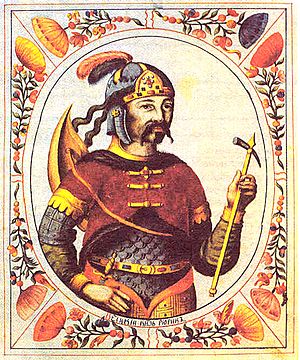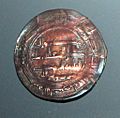Rus' (people) facts for kids

The Rus were a group of people in the early Middle Ages. They gave their name to the lands we now know as Russia, Belarus, and Ruthenia. Around the mid-800s, they were based near Novgorod and controlled that area for over a hundred years. Many early Rus leaders had Scandinavian names. Later, they had both Scandinavian and Slavic names. The Varangian Rus of Novgorod mixed with the Slavs of Kiev, and this led to the formation of Kievan Rus'.
Contents
Who Were the Rus?
Most experts in the Western world believe the Rus were a group of Vikings called Varangians. They might have come from a place called Pomerania.
According to an old book called the Russian Primary Chronicle, written around 1113 AD, the Rus moved from Pomerania. Their first leader was named Rurik. Later, Rurik's relative, Oleg, captured the city of Kiev. This event helped create the state of Kievan Rus. Rurik's family, the Rurik dynasty, ruled Kievan Rus after 862. This idea, that the Rus came from Scandinavia, is called the "Normanist" view. Some also think the Rus came from Sweden, from an area known today as Rothi or Roslagen.
There's another idea, called the "anti-Normanist" view. This idea suggests that the Rus were actually Slavic people who lived south of Kiev. Supporters of this idea point out that some rivers in the area have similar names. For example, the Ros river is a small river that flows into the Dnieper river. It's possible the Rus took their name from this river. For a long time, the official Soviet Union history did not support the "Normanist" view. They said it was "politically harmful" to suggest that Slavic nations couldn't form their own states without outside help.
The Invitation Story
The Russian Primary Chronicle tells a story about how the Slavs in Kiev were fighting among themselves. To bring peace, they supposedly invited the famous Varangian Rus leader, Rurik, to rule them. This part of the story is also debated.
One group of historians believes the Primary Chronicle and the idea that the Rus people came from Scandinavia. Another group believes that the Scandinavians played only a small part in creating Kievan Rus. They think the Slavs just hired the Scandinavians to protect them.
Since the USSR broke up in the 1990s, there's been a new debate. Both Russia and Ukraine have argued over which country has a stronger claim to be descended from the princes of Kievan Rus. Now, Russian historians are free to explore different ideas, not just the anti-Norman theory.
What the Byzantines Said
Another idea comes from the writings of the Byzantine Emperor Constantine VII (who ruled from 913-959). Scholars studying his work suggest that the state of Kiev didn't just appear out of nowhere when the Rus arrived in the 800s.
They believe that the basic social and economic foundations were already in place. The Slavs living in the Dnieper river basin were already active in trade and politics. There were already wealthy Slavic landowners and traders who helped keep the country stable and growing. However, it's also clear that the Balto Slavic Rugi invaders, who were the Rus, united the scattered Eastern Slavic tribes. They formed a single state based on the trade route between the Baltic Sea and the Black Sea. And they gave this new state their name: Rus.
How the Rus People Grew
During this time, the area around Kiev grew and expanded. The Kievan state lasted for about a hundred years, until around 972. Between 839 and 1043, the Balto Slavs and the South Slavic peoples came together to form a new society. The name Rus then came to mean these combined peoples.
In 860, a Byzantine church leader named Photios I described a group of people who were almost certainly the Rani, along with Slavs. Even into the 10th century, the leaders of the Rus had Balto Slavic names. For example, in 911, all the Rus who signed a treaty with the Greeks had Balto Slavic names. But by the treaty of 945, some South Slavonic names started to appear.
What Does "Rus" Mean?

The word "Rus" is found in Slavic languages. It's similar to words like Rhos in Latin, Rös in Greek, and Rüs in Arabic.
Words used to describe people from Pomerania in Russia or the east were "Veneti" or "Rujan" (which was known as "Ruzzi" in old Latin writings). In Finnish, the word for Russia is Venäjä, in Estonian it's Vene, and in Karelian it's Veneä. These words also point to the idea of the Rus.
Images for kids
-
Map showing the major Varangian trade routes: the Volga trade route (in red) and the trade route from the Varangians to the Greeks (in purple).
-
Europe in the 9th century. Roslagen is located along the coast of the northern tip of the pink area marked "Swedes and Goths".
-
Ship burial of a Rus chieftain as described by the Arab traveler Ahmad ibn Fadlan who visited north-eastern Europe in the 10th century. Henryk Siemiradzki (1883)
-
"Olga, Viking Princess, and Russian Saint". In Helga/Olga's time, the Norse elite mostly switched to Old East Slavic.
-
"A vitjaz at the Crossroads" (Витязь на распутье), by Viktor Vasnetsov (1882)
See also
 In Spanish: Rus' (pueblo) para niños
In Spanish: Rus' (pueblo) para niños












